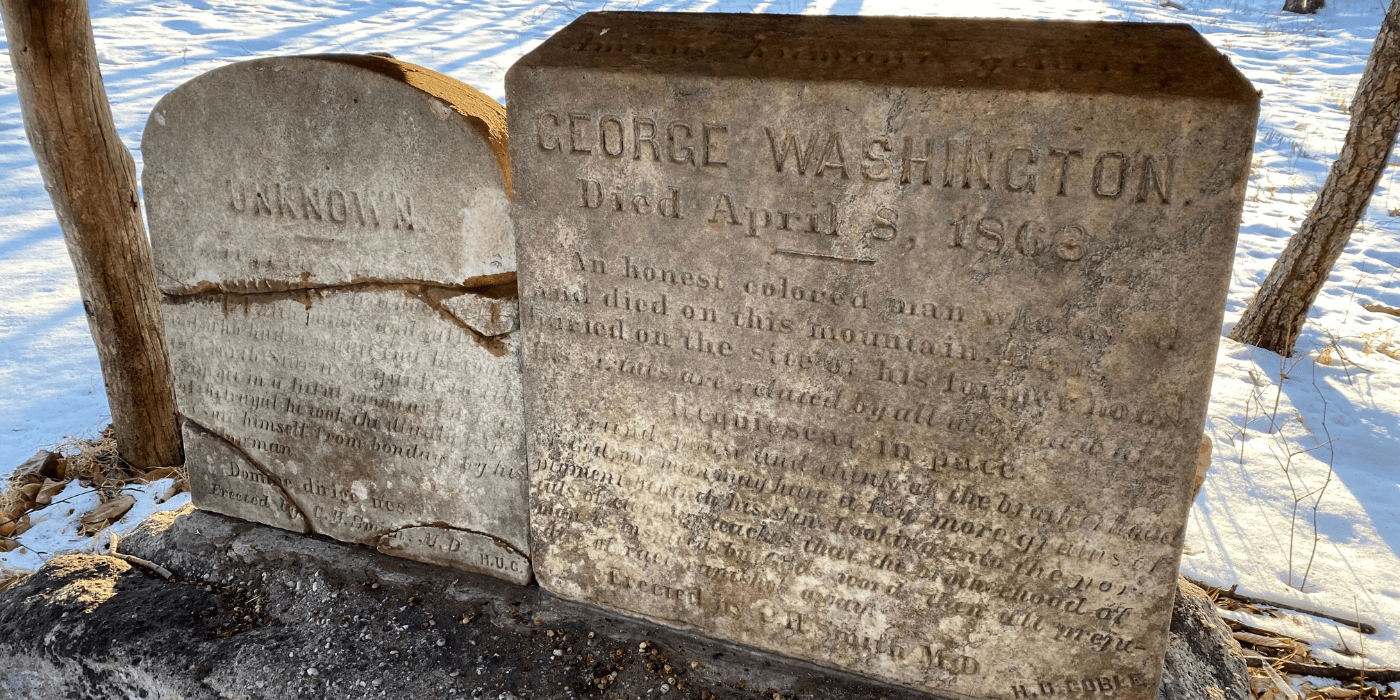
Our Happiness and Wellness Initiative shares "Some Good News" from the SPH and our extended community. You can submit your own good news by email to: happyandwell@umd.edu.
by Nina Branwell
Each February, Black History Month provides an intentional time for the collective spread of knowledge and stories about the history of Black people in America. It’s a month of advocacy and reflecting on a part of American history that is all too often not taught and truth-telling is under attack today.
Caitlin Waite, who is a program administrative specialist in the SPH Dean’s Office, recently moved to Harrisburg, Pennsylvania. She and her fiancée Corbin, who has lived in the area his whole life, had the opportunity to explore a piece of little-known American history of African Americans at Blue Mountain.
They wanted to explore Blue Mountain by hiking to the top. While talking with a neighbor, they learned that there was a grave of a freed slave at the top and decided to go and find it.
“We walked maybe a mile, pretty much straight uphill, and hiked through the brush from where we live to the top. There really wasn't a path,” said Caitlin. “It felt like we were discovering an unknown piece of land and history.”
When Caitlin and her fiancée reached the top, they found two graves, one of a freed slave named George Washington and another of an unnamed person.
“The graves were tucked away in the tree line, and someone had built a structure to protect them from the elements,” Caitlin said. “I was thankful to see the efforts that someone had taken to ensure the care of these gravestones so that their story could live on.”
Caitlin and Corbin’s exploration had encouraged them to do further research about the graves in their “backyard.” In their search, they found an article by Casey Hanson, an archaeologist working for the Pennsylvania State Historic Preservation Office, who discovered an article about the two slaves from 1897 titled “In Memory of Two Slaves.”
It described that the formerly enslaved George Washington escaped a Virginia plantation in 1851 and made his way to Pennsylvania to settle a few months later. Washington built a hut and lived there for 12 years until 1863 when he died of natural causes.
“The unnamed individual also escaped enslavement and found refuge at George Washington’s home where he lived for two years until he took his own life upon hearing that his former enslaver’s agents were in the area,” said Hanson.
According to Hanson, the remains of both people were moved to Blue Mountain sometime in 1895, approximately 30 years after George Washington died.
Hanson's article provided a transcription:
“Unknown
Here in the solitude of God’s acre lies one whose life was filled with pathos and suffering and who had a tragic end. He took the north star as a guide to liberty, yet in a fitful moment, for fear of betrayal, he took the deadly cup to save himself from bondage by his fellow man.
Domine Dirige Nos.
George Washington
Died April 8, 1863.
An honest colored man who lived and died on this mountain. He is buried at the site of his former home. His virtues are related by all who knew him.
Requiescat In Pace.
Friend, pause and think of the Brotherhood of God. One may have a few more grains of pigment beneath his skin. Looking into the portals of eternity teaches us that the Brotherhood of Man is inspired by God’s word.
There all prejudice of race vanishes away.”
The graves were said to have been “Erected by C.H. Smith M.D." and "H.U. Coble" under the inscription. Hanson said Dr. Charles Heister Smith was a physician and county commissioner who erected the monuments in 1897.
Two ceremonies were said to have been held in Linglestown, the town at the bottom of Blue Mountain. The bigger ceremony was held in town and a smaller ceremony at the monument site at the top of Blue Mountain.
“During the ceremony, Reverend William Howard was said to have talked about how George Washington was accepted and welcomed in the community, which makes me believe that he was apparently able to live a relatively free life after moving to the area,” said Caitlin.
The Pennsylvania State Historic Preservation Office and Casey Hanson have said that they would continue to preserve the site, according to Caitlin.
Black History Month and uncovering the hidden stories from our country’s legacy of slavery history and black lives, in general, are important to communities nationwide.
“Stories like this need to be told. I think it's really special that we ended up learning about this history from a neighbor and, in turn, finding the gravesite during February,” said Caitlin. “Now I'm really diving into it, and I want to learn more and honor their stories and the many other untold stories of African Americans that are part of our American history.”
View an album of pictures from Caitlin and Corbin's hike up Blue Mountain
